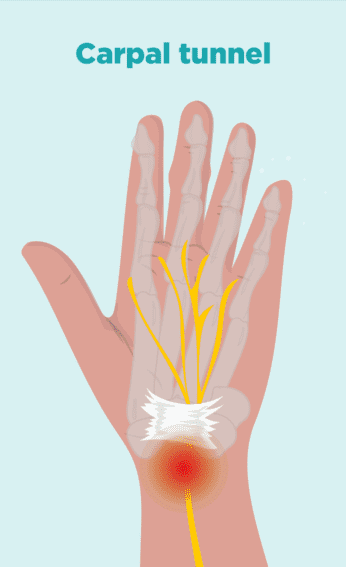Carpal tunnel syndrome is a common condition that occurs when the median nerve, which runs from the forearm into the hand, becomes compressed or squeezed at the wrist. This can result in a range of symptoms that can impact a person’s quality of life, such as pain, numbness, and weakness in the hand and wrist.
Causes of Carpal Tunnel Syndrome:
There are several factors that can contribute to the development of carpal tunnel syndrome. These include:
- Repetitive hand and wrist movements: performing repetitive movements with the hand and wrist, such as typing or using a computer mouse, can increase the likelihood of developing carpal tunnel syndrome.
- Anatomical factors: certain physical characteristics of the wrist and hand can increase the risk of carpal tunnel syndrome, such as a smaller carpal tunnel or a misalignment of the bones in the wrist.
- Medical conditions: certain medical conditions, such as diabetes, thyroid disorders, and rheumatoid arthritis, can increase the risk of carpal tunnel syndrome.

Symptoms of Carpal Tunnel Syndrome:
The symptoms of carpal tunnel syndrome can vary in severity, and can include:
Numbness or tingling in the thumb, index, middle, and ring fingers,
- Pain or discomfort in the hand and wrist
- Weakness in the hand or wrist
- Difficulty gripping or holding objects
- In some cases, the pain and discomfort can extend up the arm and into the shoulder
Treatment Options:
There are several treatment options available for carpal tunnel syndrome, including:
- Rest and immobilization: avoiding activities that aggravate the condition and wearing a wrist splint can help to alleviate symptoms.
- Medications: nonsteroidal anti-inflammatory drugs (NSAIDs) and corticosteroids can help to reduce inflammation and relieve pain.
- Physical therapy: exercises and stretches that are designed to strengthen the muscles in the hand and wrist can help to alleviate symptoms and prevent the condition from worsening.
- Surgery: in severe cases, surgery may be recommended to relieve pressure on the median nerve.
Why Chiropractic Care is a Great Option for Carpal Tunnel Syndrome:
Chiropractic care can be an effective treatment option for carpal tunnel syndrome, as it focuses on restoring proper alignment and function to the musculoskeletal system. This can help to relieve pressure on the median nerve and alleviate symptoms such as pain, numbness, and weakness.
Many times, carpal tunnel syndrome may not actually occur from what is happening at the wrist. In many cases the symptoms of this syndrome can occur from nerve entrapment at other locations such as near the elbow, shoulder or neck. Additionally, irritation of a neck, or cervical, intervertebral disc is the cause of the symptoms. Chiropractors are trained to look for all potential causes of these carpal tunnel syndrome symptoms and help to reduce these symptoms and allow the body to heal in a normal, natural manner.
Chiropractors use a variety of techniques to treat carpal tunnel syndrome, such as spinal adjustments, soft tissue therapies, and exercises that are designed to improve range of motion and flexibility in the wrist and hand. Chiropractic care is non-invasive, has minimal if any side-effects, and is less expensive than many other treatment options.
In addition, chiropractors can provide patients with advice on lifestyle modifications, such as ergonomic adjustments to workstations, that can help to prevent the condition from worsening.
Chiropractic Care Utilizing Zone Technique for Carpal Tunnel Syndrome
Any Zone Technique healer, including Dr. Post, knows exactly what to do for any condition walking into the office, including carpal tunnel syndrome. Since Zone Technique is able to unlock and unleash the powerful healing ability withing your body, your healing results will be ultimately better than any other healing technique available today. Whether you have or someone else you know has carpal tunnel syndrome, balancing the body by utilizing Zone Technique will heal your body on a deep level. Zone Technique healing is natural, effective, and permanent so that you will heal completely, function great and no longer have pain. You can be totally healthy again – feeling great and functioning perfectly from head to toe every day of the year!
If you don’t live close enough to see Dr. Post, search for a certified Zone Technique healer closer to you by searching the ZONE TECHNIQUE PRACTITIONER DIRECTORY. You owe it to yourself to take action so that you can heal and feel awesome again.
Conclusion:
Carpal tunnel syndrome is a common condition that can cause a range of symptoms that can impact a person’s quality of life. While there are several treatment options available, chiropractic care can be an effective, non-invasive, and affordable option for managing the symptoms of carpal tunnel syndrome. If you are experiencing symptoms of carpal tunnel syndrome, it is important to consult with a healthcare professional to determine the best course of treatment for your individual needs.

